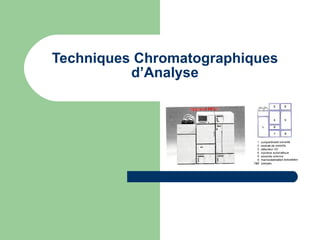Denunciar
Compartilhar

Recomendados
Recomendados
Mais conteúdo relacionado
Mais procurados
Mais procurados (20)
Sulforhodamine B (SRB) Assay Of Curcumin Loaded Nanoemulsion By Using Gliobla...

Sulforhodamine B (SRB) Assay Of Curcumin Loaded Nanoemulsion By Using Gliobla...
PPT ON Thin layer chromatography ,Principle,System Components,Procedure,Analysis

PPT ON Thin layer chromatography ,Principle,System Components,Procedure,Analysis
Chiral chromatography & ion pair chromatography

Chiral chromatography & ion pair chromatography
Destaque
Destaque (19)
Dosage des constituants majoritaires d'huiles essentielles par SFC-UV

Dosage des constituants majoritaires d'huiles essentielles par SFC-UV
Cours Chromato
- 6. Classification des méthodes chromatographiques
- 7. Paramètres chromatographiques Où tm = temps de rétention d’une substance non retenue sur la colonne tr = temps rétention t’r = temps rétention réduit d’où t’r= tr – tm = largeur du pic à la base = largeur du pic à mi-hauteur h = hauteur du pic
- 8. Le facteur de capacité K’ ( rétention) K’= Quantité de soluté dans la phase stationnaire Quantité de soluté dans la phase mobile K = : substance non retenue par la phase stationnaire K≤ 1 : composé peu retenu sur la colonne 1 ≤ K ≤ 15 : domaine optimal de séparation
- 9. Le facteur de sélectivité α Facteur de sélectivité ou de séparation : rapport des facteurs de capacité de deux solutés dont on veut réaliser la séparation.
- 10. La résolution R La résolution est une mesure de la qualité d’une séparation. Deux caractéristiques déterminent le degré de recouvrement des pics : a) la distance séparant les sommets de deux pics mesurée par t r2 - t r1 ; b) la largeur des pics à la base w. a) les pics se recouvrent; b) la distance séparant les sommets des pics est plus grande mais les largeurs à la base sont les mêmes qu’en a); c) la distance séparant les sommets des pics est égale à celle trouvée en a) mais les largeurs à la base sont plus petites qu’en b).
